Oregon’s Hayward Field: Then and Now
In the annals of track and field, Hayward Field is legendary, and the World Athletics Championships (the first to be held on U.S. soil) will be the ultimate showcase for the new facility. In this retrospective, Canadian athletes reminisce about their experiences on Oregon’s storied track
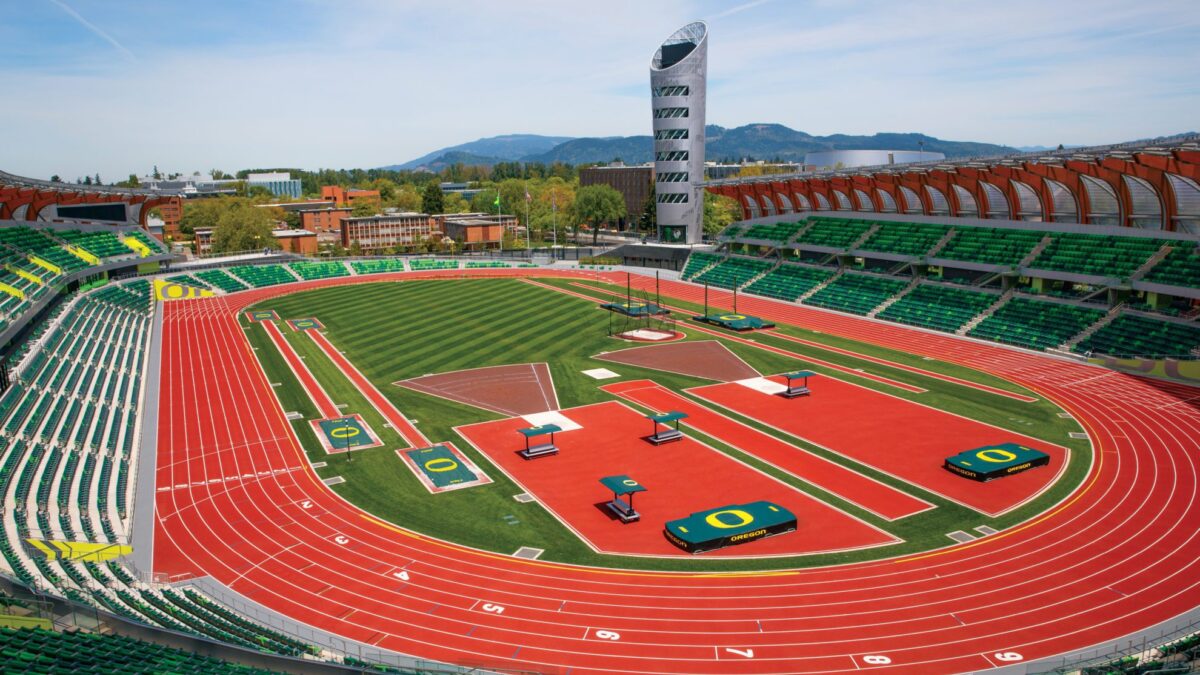 Photo by:
University of Oregon Athletics
Photo by:
University of Oregon Athletics
This article first appeared in the July & August 2022 issue of Canadian Running magazine.
American athletes have dominated the World Athletics Championships, the crown jewel of the sport, ever since the IAAF (as World Athletics was previously known) introduced the event in 1983. But until this year, none of the 18 editions has been held on U.S. soil. That’s all about to change, as roughly 1,800 athletes from across the globe descend on Eugene, Ore., for the 2022 World Athletics Championships, from July 15 to 24.
Past editions of these world championships have been held in the Olympic stadia of Helsinki (twice), Rome, Tokyo, Berlin, Moscow, Beijing and London—all esteemed locations steeped in history. There are many who will wonder how on earth Eugene’s Hayward Field, located right on the campus of the University of Oregon, deserves such a prestigious event.
To be fair, Hayward Field underwent a massive renovation from 2018 to 2020, with the rickety, old wooden stands being replaced in order to increase the permanent seating capacity from 10,500 to 12,650; for these world championships, the stands will be expandable to a respectable 25,000. An enormous video screen has also been added, along with a 10-storey tower, which pays tribute to University of Oregon legends Bill Bowerman (coach), Steve “Pre” Prefontaine, Raevyn Rogers, Ashton Eaton and Otis Davis.
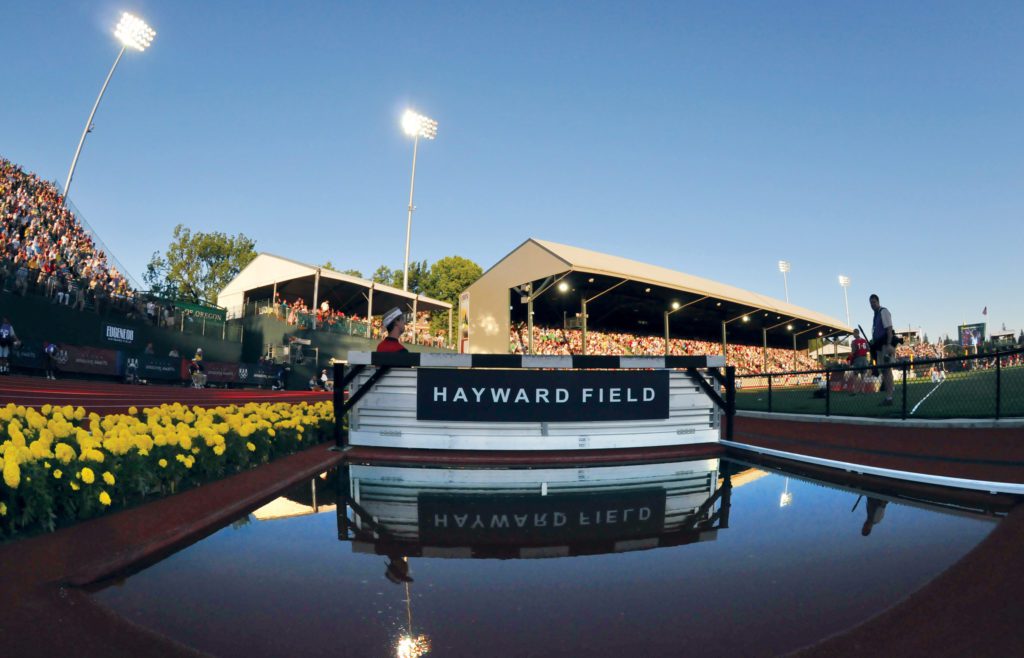
In truth, athletes who have competed at Hayward Field, or whose contemporaries have spoken of the place in glowing terms, eagerly await the chance to compete for global medals here. It is truly a rite of passage, for Eugene itself has enjoyed the nickname “Track Town, USA” for many years.
The track was replaced with a nine-lane Beynon BSS 2000 surface, which company spokesperson Iannick di Sanza says is “the best of the best” for its shock absorption and reduction. Unlike other polyurethane surfaces that are laid in strips, Beynon pours layers of the material, allowing them to harden between takes. With an eye to enhancing the spectator experience, the concourse level of the stands has also been fitted with this product.
Canada’s Moh Ahmed, the Olympic 5,000m silver medallist, has raced at Hayward Field many times, both as a collegiate athlete at the University of Wisconsin and as a member of the professional Bowerman Track Club, which is named after the late Oregon coach and Nike co-founder, Bill Bowerman. Ahmed was third in the 2014 NCAA 10,000m there and also set a Canadian 5,000m record on the track in 2016 (13:01.74—which he has since lowered to 12:47.20). He is planning a 5,000m/10,000m double at this year’s world championships, and is, naturally, delighted that they will be held just 90 minutes from his home in Portland. When he thinks of stepping onto the track as a college athlete for his first Hayward Field race, fond memories come to mind.
“What really stood out was, definitely, the crowd,” the St. Catharines, Ont., native recalls. “It seemed like there were 30,000 people there every day, even though the capacity was much less than that.
“The crowd was a shock to me. I was used to meets in Canada. Even the Canadian championships, sometimes, they can seem like a ‘twilight meet,’ because the seats are empty. I was just shocked to see that kind of college football atmosphere at a track meet. It was pretty incredible.”
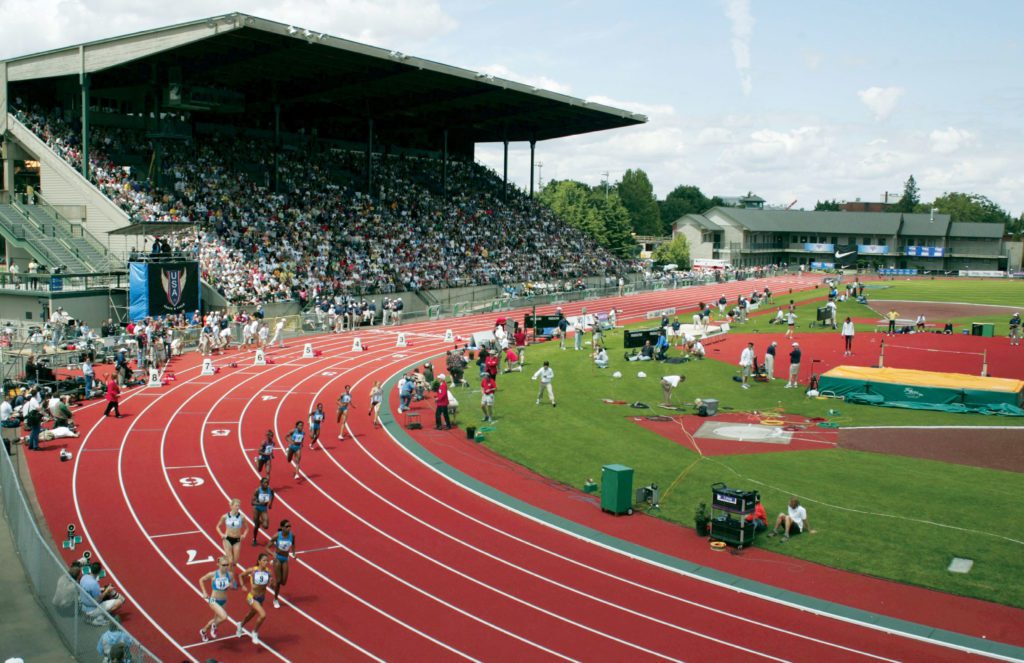
Since the stadium was built for track and field, the sight lines are excellent. The fans are right next to the track, something most of the athletes enjoy. After Ahmed returned to Portland following his Tokyo Olympic silver medal, he raced the mile at the 2021 Pre Classic, finishing in 3:53.87—a new personal record. Having raced at both the historic Hayward Field and the new facility, he offers exuberant praise for what they have done with the place.
“I got a chance to check out the new stadium last August after the Olympics. It is a track and field fan’s heaven,” he says. “If you are a track fan, you have got to make the journey out here for these world championships. The stadium looks so sick! It is so athlete-friendly, the atmosphere is very intimate and the capacity is bigger. It’s incredible, honestly.”
Ahmed’s first exposure to the Hayward Field legend was through films depicting the life and times of Prefontaine, the legendary University of Oregon distance runner. Without Limits and Prefontaine were released in the late ’90s and achieved cult status, as did the man himself.
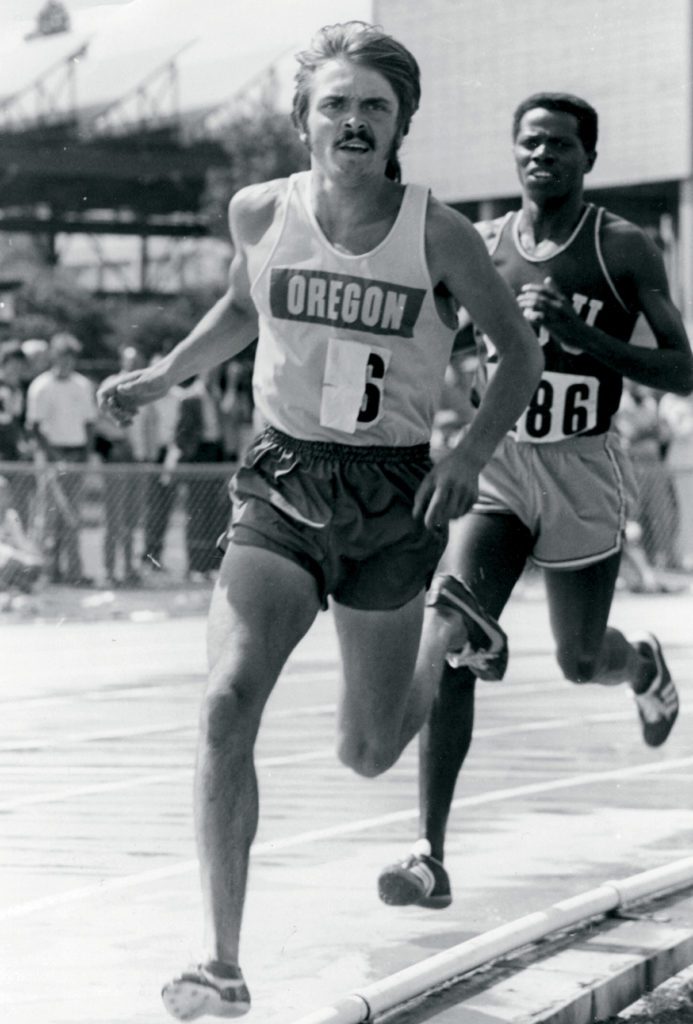
The Prefontaine Classic, always one of the highlights of the World Athletics Diamond League circuit, honours the legendary runner, who held American records from 2,000m to 10,000m during his short career. (He died in 1975 when his sports car flipped, crushing him.)
Pre’s popularity was such that thousands of fans would turn up, not just to witness him racing, but also to watch him run time trials at Hayward Field. Track fans of a more mature age are likely to recall where they were the moment they heard of Pre’s death. And many fans visit the site of the crash, which has been dubbed “Pre’s Rock.” The legends around Pre and Hayward Field are really inextricable.
Those two films about Prefontaine that Ahmed enjoyed also became an integral part of the coaching strategy for Lynn Kanuka, the 1984 Olympic 3,000m bronze medallist, when she used to take young Canadian athletes to Eugene for the Oregon Relays meet. Kanuka used the weekend as a teaching opportunity for her athletes. “We would have a ‘Pre night,’” Kanuka remembers. “I would make them all watch the movies together. And they would be all psyched. They all ran out of their trees as well, or, went out too hard and ‘died’ because they were so excited.
“We would always go have pancakes at IHOP and go to Pre’s Rock and pay homage to the great one,” Kanuka says. “Some of them were with me five years or more; if they made the trip, they would have to put up with it every time.” Kanuka laughs at the memory.
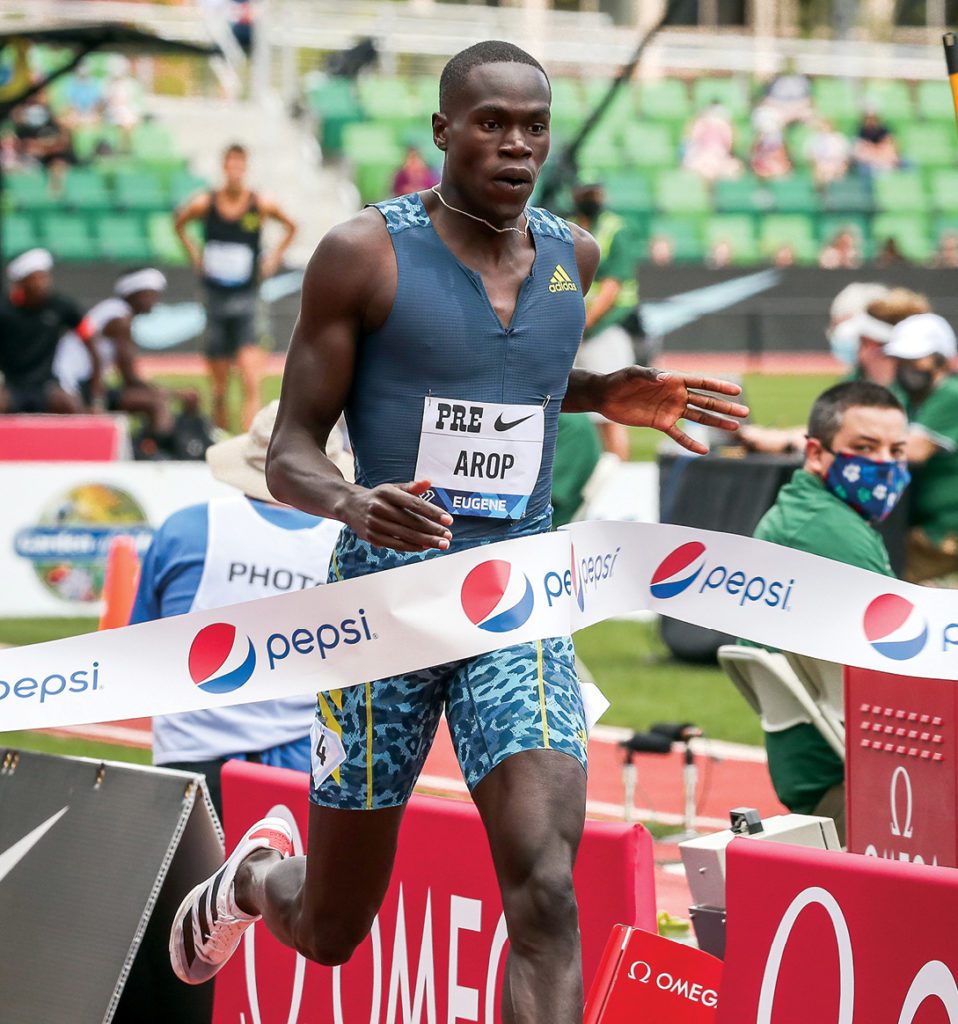
Kanuka ran the Pre Classic three times, winning the 3,000m in 1989. She recalls that, compared with even some of the major European meets, racing in Eugene was on a different scale. “When I ran there in ’89, Ingrid Kristiansen was there, and she was a 10,000m specialist,” Kanuka says of the Norwegian running legend. “I remember thinking, ‘I am going to run my pace, and in the end, I will be faster.’ I found myself out front, and the crowd did that for me. They were clapping, clapping, clapping … because that crowd appreciated an effort.”
It’s one thing for visiting athletes and coaches to offer a testimonial about the facility, but many Canadian athletes have attended the University of Oregon over the years and have experienced the Hayward Field magic on a more regular basis. One notable is Brianne Theisen-Eaton, who earned the 2016 Olympic heptathlon bronze medal, as well as silver at both the 2013 and 2015 world championships. “When I first got to the University of Oregon for a visit in Grade 12, I knew the name Prefontaine, but had no idea what he stood for,” she explains. “I didn’t know the name Bill Bowerman or that Nike came out of Eugene. So learning all this on my visit was pretty eye-opening.”

“Coming from Saskatchewan, where all but two of the tracks were dirt, then coming into Eugene, where there was this amazing stadium with a history, it was just shocking.”
Theisen-Eaton was even more surprised at how track-and-field fever was so prevalent, not only at the stadium, but in the everyday life of the residents.
“It wasn’t just at track meets,” she says. “It was at the grocery store. It felt like a community, even when you were out and about doing stuff. People let you know, ‘We are rooting for you.’ It did make a huge difference at the track meets, to have knowledgeable fans, especially in the field events. They just know you clap for these people. It wasn’t like the athlete had to educate the crowd, going, ‘OK, I need your support.’ They would just do it.”
Of all the positive memories Theisen-Eaton has of her time competing at Hayward Field, feeling the support of the crowd, one incident stands out. Eugene hosted the 2010 NCAA Championships, and she had just won her second of three NCAA heptathlon titles when she realized that she would be drafted into Oregon’s 4 x 400m relay team.
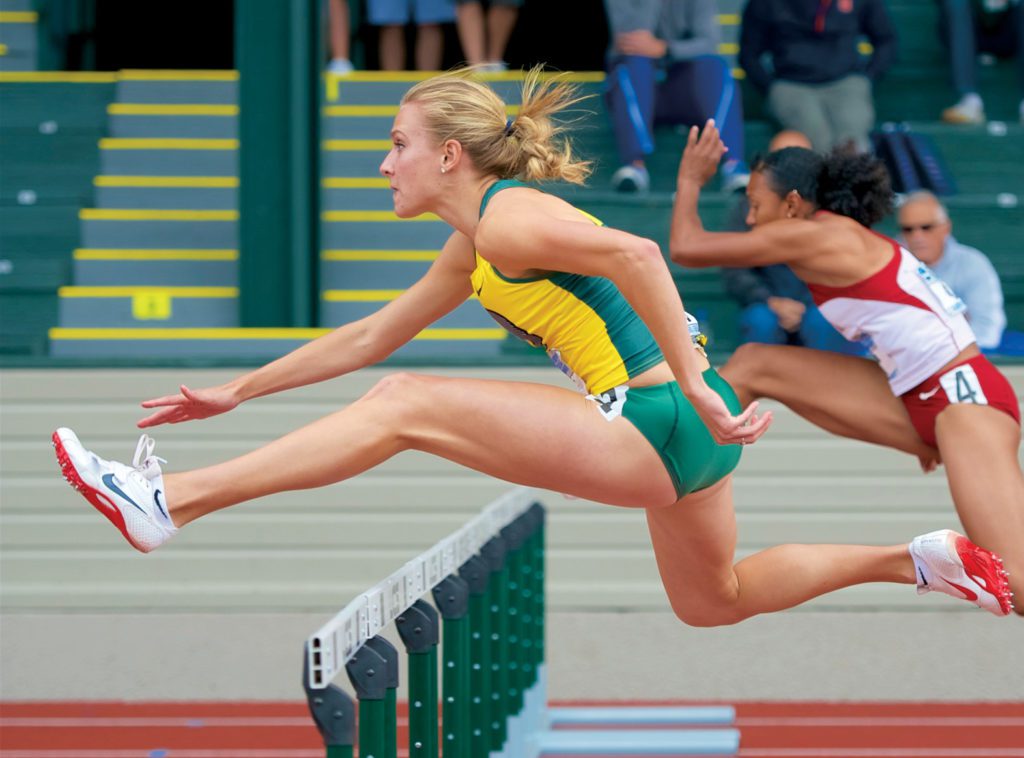
“I was obviously very nervous, having to run the NCAA 4 x 400m final,” she says, “and I remember the men’s 1,500m final was just before us. So we were under the west grandstands, where they were getting all the teams ready. That’s when [Oregon runners] Andrew Wheating, A.J. Acosta and Matt Centrowitz went one, two, three in the men’s 1,500m.
“The crowd was so loud. They were stomping their feet, and stuff was falling from the ceiling—dust and rocks and dirt. I never heard it so loud! I think that’s the point where I was thinking, I don’t need to be nervous. This crowd is behind me. I was the lead-off runner, and thinking, they are going to cheer me around the track. And they did. Our team won the NCAA 4 x 400m. It was so cool!”
Theisen-Eaton lives in Portland with her husband, two-time Olympic decathlon champion Ashton Eaton (whom she met at Oregon), and their son; their second baby is due shortly. She believes the new Hayward Field has retained some of its legendary features.
Perhaps the Canadian who has spent the most time eyeballing Hayward Field is former Oregon Duck Peter Fonseca, who went on to finish 21st in the 1996 Olympic marathon. Fonseca’s dorm room overlooked Hayward Field, and his roommate was Joe Dellinger, son of Oregon coach Bill Dellinger.
“When I looked out my window, on any given day I could see Mary Slaney, Alberto Salazar, Ron Tabb—people who had run some pretty incredible times, some American records holders,” says Fonseca, now the member of Parliament for Mississauga East. “I would watch sub-four-minute milers work out. I would sit there and do my homework and peep out the window and see these amazing runners. It was a really special place for me.
“At the end of the 1987 season, when they were going to rip out the old track [it was converted from 440 yards to a new 400m surface], people were very nostalgic about it. But I didn’t really grasp the history of the place. Again, I looked out my window one morning, and I see all these people out on the track with knives, cutting out pieces of the track. If I’d known then what I know today, I would have been out there myself. What that speaks to is how special a place it is.”
Fonseca ran both his 5,000m and 10,000m PBs at Hayward Field, urged on by the crowd, who knew he was chasing NCAA qualifying standards. Today, Fonseca still has his Oregon singlet, framed and hanging in his home. In those days, the mother of accomplished Oregon distance runner Bill McChesney hand-sewed the team singlets—another example of the communal atmosphere in Eugene.
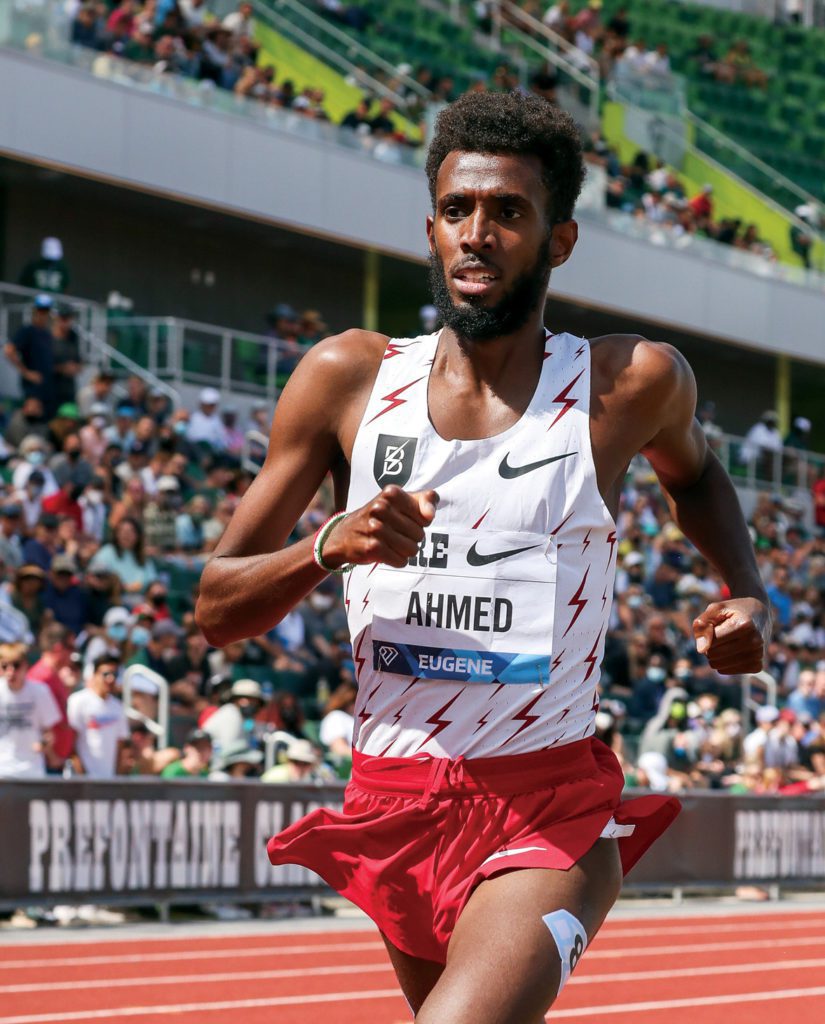
“To have those things in the mix will make things more exciting. So I will be racing nationals from June 23 to 26 [in Langley, B.C.] and then fly to Edmonton to compete on July 3. Afterward, I will head to Eugene for the world championships. Having everything on that side of the continent is going to make things so much easier.”
Ahmed will be one of the four Canadian medallists from Doha 2019 expected to compete in Eugene; the others are Damian Warner (who won the decathlon gold medal in Tokyo), 50 km race walk bronze medallist Evan Dunfee and 100m bronze medallist Andre De Grasse. Unfortunately for Dunfee, the 50K is no longer to be contested at the world championships or Olympics and has been replaced by the 35K.
Canada’s sprint relay team wound up with the silver medal from Tokyo and will certainly be a medal contender again. And of course, the fortunes of Andre De Grasse are an integral part of Canada’s potential. The Olympic 200m champion and 100m bronze medallist has had a positive experience at Hayward Field, winning the 2021 Pre Classic 100m in a windy 9.74 seconds. Optimism is therefore in abundance.
Among track fans, Eugene is known for Hayward Field. These 2022 World Championships will undoubtedly put the city on the world map, alongside the great capitals that have hosted in the past, and the performances we can expect will most certainly justify the selection of this venue as host city.
Paul Gains is a full-time freelance journalist. He has covered 11 outdoor IAAF outdoor World Championships and five summer Olympic Games.


